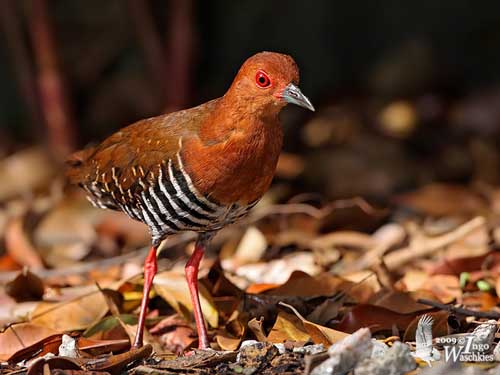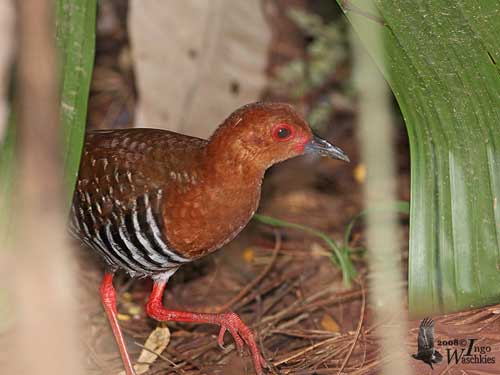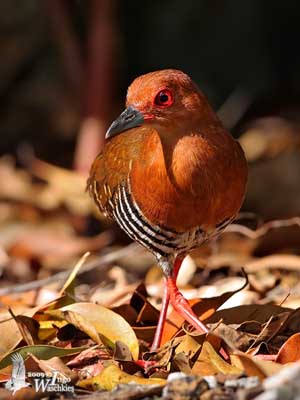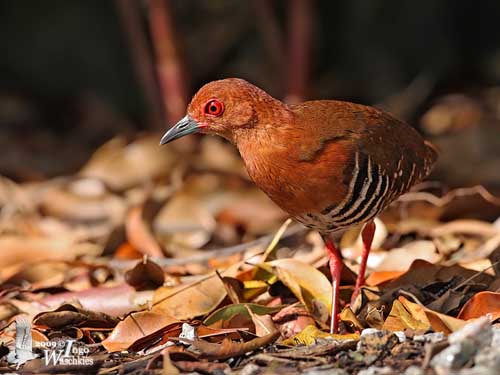
DIET:
The Red-legged Crake feeds on aquatic invertebrates, earthworms and other small aquatic preys.
PROTECTION / THREATS / STATUS:
The Red-legged Crake is difficult to observe because it is often concealed in the dense vegetation during the day.
This species is widely distributed but not very common. However, it is evaluated as Least Concern by Birdlife International.
Fr: Râle barré
All : Malaienralle
Esp: Polluela Patirroja
Ital: Rallina fasciata
Nd: Roodpootral
Sd: Rödbent bandrall
Photographer:
Ingo Waschkies
My bird pictures on Pbase
Text by Nicole Bouglouan
Sources:
HANDBOOK OF THE BIRDS OF THE WORLD Volume 3 by Josep del Hoyo-Andrew Elliott-Jordi Sargatal - Lynx Edicions - ISBN : 8487334202
L’ENCYCLOPEDIE MONDIALE DES OISEAUX - Dr Christopher M. Perrins - BORDAS - ISBN: 2040185607
BirdLife International (BirdLife International)
Wikipedia, the free encyclopaedia
XENO-CANTO – Sharing Birds sounds from around the world
Red-legged Crake
Rallina fasciata
Gruiforme Order – Rallidae Family
BIOMETRICS:
Length: 23-25 cm
DESCRIPTION:
The Red-legged Crake is a bright coloured bird, inhabitant of several types of wetlands.
The adult male has brown upperparts, including wings and tail. The wing-coverts are finely barred white. Head, neck and breast are bright reddish-brown, with slightly paler chin and throat.
Belly, flanks and undertail-coverts are conspicuously barred black and white, as the underwing.
The bill is greenish-grey with red base. Eyes, narrow eye-ring, legs and feet are red.

The female resembles the male but she has more cinnamon on head and neck, and belly and flanks exhibit narrower black bars.
The juvenile is grey with greyish-brown upperparts, white bars on the upperwing-coverts and black crown. Bill, eyes, legs and feet are dark grey.
VOICE: SOUNDS BY XENO-CANTO
The Red-legged Crake gives advertising calls at night, a loud “gogogogok”. We can hear this call during the rainy days, and also a “girrrr”. During the breeding season, several nasal “pek” are uttered at dawn and dusk as territorial calls, and also a slow descending trill.
HABITAT:
The Red-legged Crake frequents swamps and marshes with reeds, ricefields, rivers and streams and also the riparian wet areas in forest, and can be seen in thickets and secondary growths.
This species is usually seen up to 800 metres of elevation, but during the migrations, it can occur higher, up to 1400 metres.

RANGE:
The Red-legged Crake occurs in NE India, S Burma, Thailand, Malay Peninsula, Borneo and Indonesia. This bird may be sometimes vagrant to NW Australia.
BEHAVIOUR:
The diet of the Red-legged Crake is poorly known, only from some observations. This bird feeds on worms. Once the worm is pulled out of the ground, the crake hits it strongly against the ground to kill it before swallowing.
It also catches worms among the leaf litter, using its bill to turn over the leaves and to reach the preys. It is also able to probe into the soft soils to find invertebrates.
It often forages under the vegetal cover, and emerges in more open areas only at dusk.
This species usually forages alone, in pairs or in small family groups after the nesting period.

The Red-legged Crake is considered mainly winter visitor in the southern parts of the range. The movements of this bird are not well understood because this species seems to be both resident and migratory in normal range. It is probably dispersive according to the water levels and the food availabilities.
They often move by night and their migrations are difficult to follow.
FLIGHT:
As other Rallidae species, the Red-legged Crake has laboured and fluttering flight, but it is able to fly strongly and steadily when it is well under way.
REPRODUCTION:
The breeding season varies according to the range.
The nest of the Red-legged Crake is not described, but usually, they build the nest well hidden among the thick marshy vegetation.
The female lays 3-6 eggs, and both parents share the incubation. The chicks are precocial and follow the foraging adults very soon after hatching, within 2-3 days. They are independent some weeks later.
